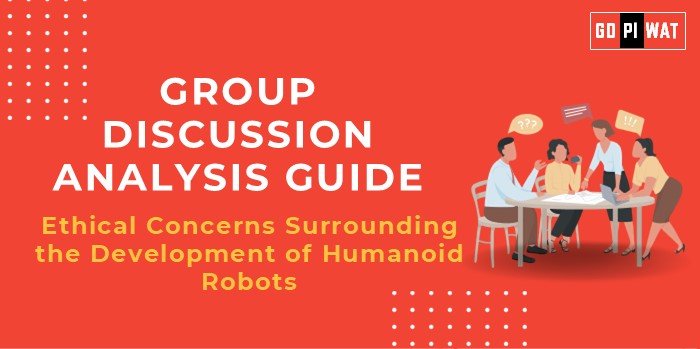📋 Group Discussion Analysis Guide: Ethical Concerns Surrounding the Development of Humanoid Robots
🌟 Introduction to the Topic
- 💡 Opening Context: Humanoid robots, which mimic human appearance and behaviors, are at the forefront of technological advancements, revolutionizing fields such as healthcare, customer service, and domestic assistance. However, their development raises significant ethical dilemmas, making it a crucial topic for B-school discussions.
- 🤖 Topic Background: The development of humanoid robots dates back to early robotics experiments but has seen exponential growth with advancements in AI and machine learning. Ethical concerns center on privacy, employment displacement, and moral questions about creating human-like machines. Recent cases, such as the introduction of AI-driven humanoids in service roles, exemplify the ethical debate.
📊 Quick Facts and Key Statistics
- 📈 Global Robotics Market Size: $45 billion (2023) – Illustrates rapid adoption across sectors.
- ⚠️ Job Displacement Risk: Up to 20% of global jobs at risk by 2030 due to automation (World Economic Forum).
- 🧑⚖️ Ethical AI Frameworks: Only 45% of countries have official AI ethical guidelines (UNESCO, 2023).
- 📊 Public Sentiment: 62% of people globally fear humanoid robots might harm societal values (Ipsos Survey, 2023).
👥 Stakeholders and Their Roles
- 🏛️ Governments: Regulate AI development and ensure ethical standards.
- 🏢 Corporations: Innovate and deploy humanoid robots responsibly.
- 📚 Academic Institutions: Research impacts and propose ethical guidelines.
- 🌍 General Public: Voice societal concerns and adapt to changes.
- 🌐 Nonprofits: Advocate for ethical AI practices globally.
🏆 Achievements and Challenges
Achievements:
- 👩⚕️ Healthcare Applications: Robots like “Grace” assist in elderly care, reducing caregiver shortages.
- 💬 Customer Interaction: AI robots enhance customer service, e.g., Pepper in retail.
- 🎓 Education: Humanoids like NAO are utilized for STEM learning worldwide.
Challenges:
- ⚖️ Ethical Dilemmas: Concerns about autonomy and moral boundaries.
- 💼 Job Displacement: Automation threatens employment in key sectors.
- 🔒 Privacy Risks: Data misuse through AI-driven humanoids raises alarm.
🌐 Global Comparisons:
- 🇯🇵 Japan: Leads in ethical humanoid development, emphasizing care robots.
- 🇺🇸🇪🇺 US & EU: Struggle with comprehensive regulation despite advanced technology.
📖 Case Studies:
- 🤖 Sophia the Robot: A celebrated humanoid sparking debates on AI citizenship and ethics.
- ⚠️ AI Bias in Recruitment Bots: Example of ethical AI misuse leading to discrimination.
💬 Structured Arguments for Discussion
- ✅ Supporting Stance: “Humanoid robots enhance productivity and bridge labor shortages in critical sectors such as healthcare and education.”
- ❌ Opposing Stance: “The development of humanoid robots exacerbates inequality, job loss, and ethical concerns about human-machine interaction.”
- ⚖️ Balanced Perspective: “While humanoid robots offer transformative potential, their integration must address ethical challenges to ensure societal benefits.”
🔑 Effective Discussion Approaches
- 📊 Opening Approaches:
- Fact-Based: “Did you know that humanoid robots could replace 20% of jobs by 2030, sparking debates on workforce ethics?”
- Question-Based: “How can we ensure humanoid robots serve humanity without compromising ethics?”
- 💡 Counter-Argument Handling:
- Rebuttal Example: “While job displacement is a concern, history shows that technological revolutions create new opportunities, provided there’s reskilling.”
📊 Strategic Analysis of Strengths and Weaknesses
- 💪 Strengths: Enhanced efficiency, healthcare potential, scalable learning solutions.
- ⚠️ Weaknesses: High costs, ethical ambiguities, risk of bias.
- ✨ Opportunities: Regulatory leadership, ethical AI development, global collaboration.
- ⚡ Threats: Public mistrust, misuse by malicious actors, unregulated AI growth.
📚 Connecting with B-School Applications
- 🌍 Real-World Applications: B-school projects could explore regulatory frameworks, ethical implications in business strategies, and risk mitigation in AI deployment.
- ❓ Sample Interview Questions:
- “What are the ethical responsibilities of businesses deploying humanoid robots?”
- “How should governments balance innovation with ethical concerns in robotics?”
- 📖 Insights for B-School Students:
- Focus on ethical AI and its role in sustainable business.
- Explore emerging markets for humanoid robots as a case study.


